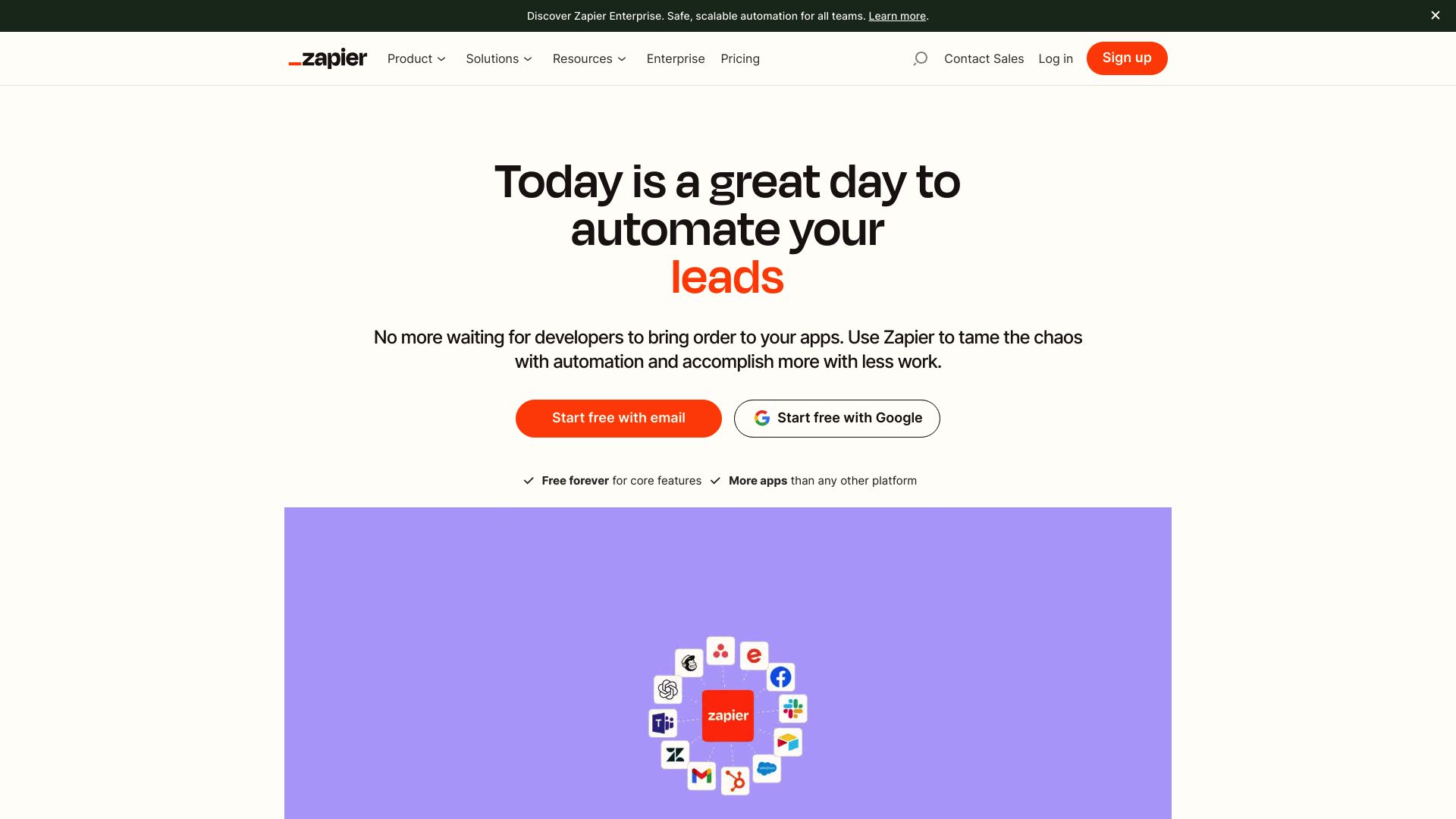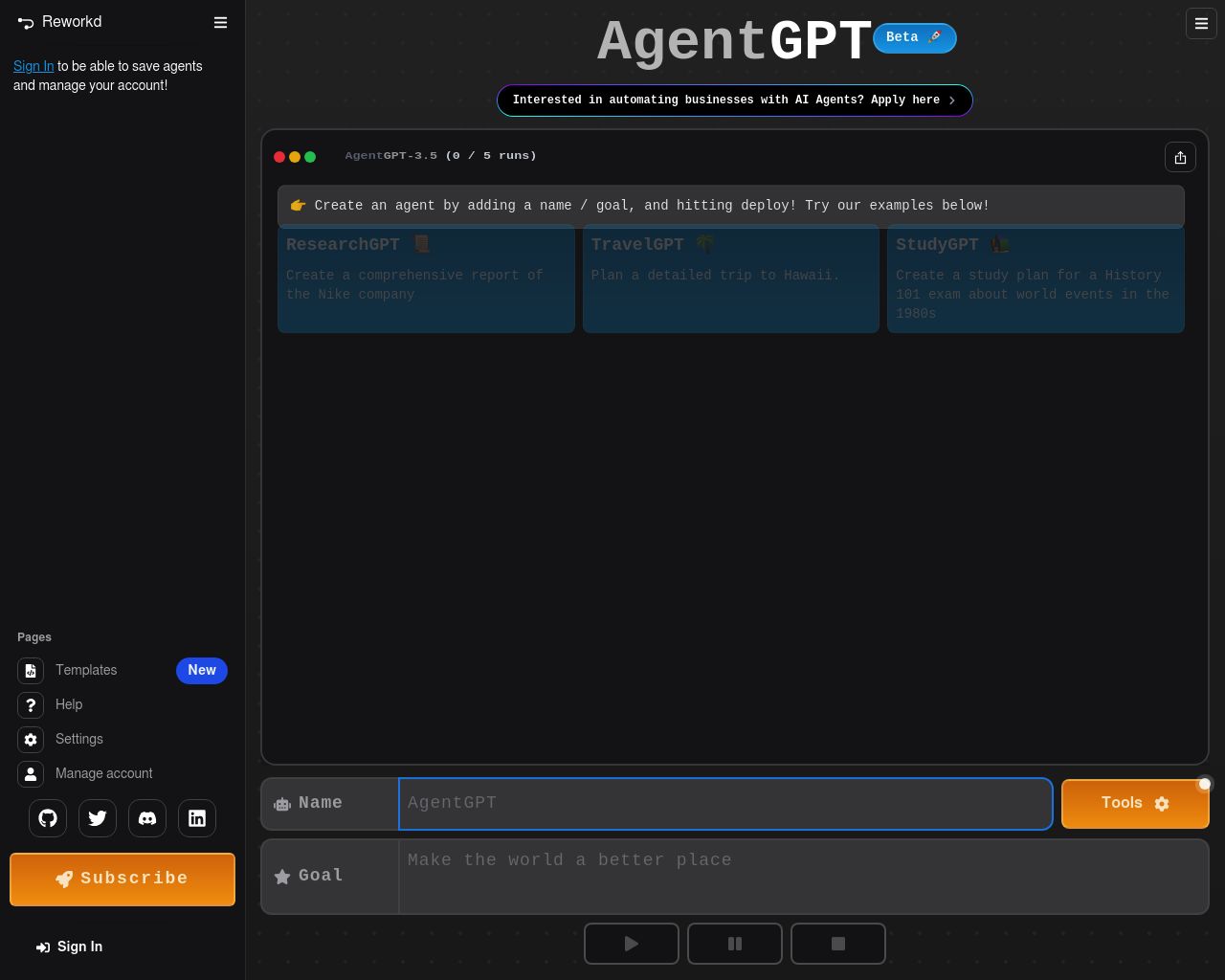Zapier vs. AgentGPT: Comprehensive AI Automation Comparison
AI-powered automation platforms are transforming how businesses streamline operations and enhance productivity. This comparison explores Zapier vs. AgentGPT, and SmythOS, three distinct solutions in the AI automation landscape. Zapier connects thousands of apps for seamless workflow automation, while AgentGPT deploys autonomous AI agents for goal-oriented tasks. SmythOS emerges as a comprehensive platform, combining extensive integrations with advanced AI capabilities. We’ll examine each platform’s strengths, limitations, and unique features to help you determine the best fit for your automation needs. Whether you’re a developer seeking powerful APIs, a business leader focused on scalability, or a non-technical user looking for user-friendly tools, this analysis will guide you through the key factors to consider when choosing an AI automation solution.
Zapier Overview
Zapier connects over 6,000 apps and services, enabling users to automate workflows without coding. The platform’s visual builder and pre-built integrations make it accessible for non-technical users to create custom automation ’Zaps’ that streamline repetitive tasks across applications.
Zapier connects over 6,000 apps and services, enabling users to automate workflows without coding.


Zapier’s strength lies in its extensive app ecosystem and user-friendly interface. Users can quickly set up automated workflows to sync data, send notifications, and perform actions across popular business tools. The platform supports both simple and multi-step Zaps, allowing for complex automation scenarios.
Users can quickly set up automated workflows to sync data, send notifications, and perform actions across popular business tools.
While Zapier excels at app integration, it lacks advanced AI capabilities. The platform doesn’t offer AI agents, autonomous decision-making, or natural language processing features. This limitation may disappoint users seeking more sophisticated AI-driven automation.
Zapier provides robust tools for developers to create custom integrations. The Zapier CLI enables building private or public app integrations, expanding the platform’s capabilities. However, the learning curve for custom development can be steep compared to the visual builder.
Scalability and security are key considerations for enterprise users. Zapier offers team collaboration features and supports OAuth authentication, but advanced security controls like IP restrictions are limited. The platform’s pricing model, based on tasks and users, may become costly for high-volume automations.
AgentGPT Overview
AgentGPT empowers users to create and deploy autonomous AI agents directly in a web environment. Unlike traditional chatbots, AgentGPT focuses on achieving broad, goal-oriented tasks. The platform’s web-based interface sets it apart from locally-operated alternatives, offering a more accessible solution for users across various technical backgrounds.


AgentGPT boasts features such as user authentication, agent run saving and sharing, dynamic translations, and AI model customization. The platform’s web browsing capabilities and Stripe integration for paid versions enhance its versatility. AgentGPT’s use of vector databases for memory management allows AI agents to retain execution history and access long-term memory, improving functionality over extended periods.
AgentGPT empowers users to create and deploy autonomous AI agents directly in a web environment. Unlike traditional chatbots, AgentGPT focuses on achieving broad, goal-oriented tasks.
The platform’s accessibility shines through its docker-compose setup, which doesn’t require an API key for local runs. This ease of use, combined with efficient cloud scaling and integration with tools like LangChain, makes AgentGPT suitable for a wide range of applications, from simple tasks to complex operations.
While AgentGPT offers impressive capabilities, it faces challenges in areas such as hosted agent environments and advanced AI features like multimodal interactions or autonomous agent collaboration. The platform’s focus on web-based deployment may limit its applicability in scenarios requiring more diverse deployment options or extensive customization.
Feature Comparison
Zapier and AgentGPT offer distinct approaches to workflow automation and AI agent deployment. Zapier excels at connecting apps and automating workflows without coding, boasting over 6,000 pre-built integrations. Its visual builder and extensive app ecosystem allow users to create complex multi-step automations quickly. However, Zapier lacks advanced AI capabilities like autonomous agents or natural language processing.
AgentGPT, on the other hand, focuses on deploying autonomous AI agents capable of achieving broad, goal-oriented tasks. It provides features like user authentication, agent run sharing, and web browsing capabilities. AgentGPT’s use of vector databases for memory management enhances agent functionality over time. While AgentGPT offers impressive AI capabilities, it falls short in areas like hosted agent environments and extensive customization options that Zapier provides for integrations.
Both platforms have gaps in core components and security features. Zapier lacks AI-specific security measures, while AgentGPT’s web-based deployment may limit its applicability in scenarios requiring diverse deployment options or extensive customization. Neither fully addresses advanced features like multi-agent collaboration or constrained alignment, highlighting areas for potential improvement in both platforms.
Feature Comparison Table
| Zapier | AgentGPT | SmythOS | |
|---|---|---|---|
| CORE FEATURES | |||
| AI Agents | ❌ | ✅ | ✅ |
| Hosted Agents (Dev, Production) | ❌ | ✅ | ✅ |
| Visual Builder | ✅ | ❌ | ✅ |
| No-Code Options | ✅ | ❌ | ✅ |
| Memory & Context | ❌ | ✅ | ✅ |
| Autonomous Agents | ❌ | ✅ | ✅ |
| Explainability & Transparency | ❌ | ❌ | ✅ |
| Multimodal | ❌ | ✅ | ✅ |
| Problem-Solving Capabilities | ❌ | ✅ | ✅ |
| Multi-Agent Collaboration | ❌ | ✅ | ✅ |
| Human-AI Interaction | ❌ | ❌ | ✅ |
| Agent Work Scheduler | ❌ | ✅ | ✅ |
| SECURITY | |||
| Constrained Alignment | ❌ | ❌ | ✅ |
| IP Control | ❌ | ❌ | ✅ |
| COMPONENTS | |||
| Foundation AIs | ❌ | ❌ | ✅ |
| Huggingface AIs | ❌ | ✅ | ✅ |
| Classifiers | ❌ | ✅ | ✅ |
| Logic | ❌ | ✅ | ✅ |
| Data Lakes | ❌ | ❌ | ✅ |
| DEPLOYMENT OPTIONS (EMBODIMENTS) | |||
| Staging Domains | ✅ | ❌ | ✅ |
| Production Domains | ✅ | ❌ | ✅ |
| Deploy as Site Chat | ❌ | ✅ | ✅ |
| Deploy as Scheduled Agent | ❌ | ❌ | ✅ |
| Deploy as GPT | ❌ | ✅ | ✅ |
| DATA LAKE SUPPORT | |||
| Hosted Vector Database | ❌ | ✅ | ✅ |
| Sitemap Crawler | ❌ | ❌ | ✅ |
| YouTube Transcript Crawler | ❌ | ❌ | ✅ |
| URL Crawler | ❌ | ✅ | ✅ |
| PDF Support | ❌ | ✅ | ✅ |
| Word File Support | ❌ | ✅ | ✅ |
| TXT File Support | ❌ | ✅ | ✅ |
Best Alternative to Zapier and AgentGPT
SmythOS stands out as the premier alternative to Zapier and AgentGPT, offering a comprehensive platform for AI agent creation and deployment. Our drag-and-drop interface simplifies the process of building complex AI workflows, making advanced AI functionalities accessible to users of all skill levels. SmythOS bridges the gap between Zapier’s integration-focused approach and AgentGPT’s AI capabilities, providing a unified solution for automation and intelligent agent deployment.
SmythOS stands out as the premier alternative to Zapier and AgentGPT, offering a comprehensive platform for AI agent creation and deployment.
Unlike Zapier, which lacks AI-specific features, and AgentGPT, which offers limited customization options, SmythOS delivers a full spectrum of AI agent development tools. We support multiple AI models, including those from OpenAI, Anthropic, and Hugging Face, allowing users to leverage cutting-edge AI technologies in their workflows. Our platform’s versatility enables the creation of everything from simple chatbots to complex, multi-agent systems capable of solving intricate problems autonomously.
SmythOS excels in areas where Zapier and AgentGPT fall short. While Zapier offers extensive app integrations, it lacks true AI capabilities. AgentGPT provides basic AI agent deployment but misses crucial features like visual builders and extensive API integrations. SmythOS combines the best of both worlds, offering robust API integrations similar to Zapier and advanced AI functionalities that surpass AgentGPT’s capabilities. Our platform supports multimodal interactions, problem-solving capabilities, and multi-agent collaboration, features absent or limited in both Zapier and AgentGPT.
SmythOS combines the best of both worlds, offering robust API integrations similar to Zapier and advanced AI functionalities that surpass AgentGPT’s capabilities.
Security and scalability set SmythOS apart from its competitors. We implement rigorous security measures, including data encryption and OAuth authentication, ensuring your AI agents operate in a secure environment. Our platform’s scalability allows seamless growth from small-scale deployments to enterprise-level operations, a critical feature for businesses looking to expand their AI capabilities over time. With SmythOS, you’re not just getting a tool; you’re investing in a future-proof solution that evolves with your needs and the rapidly advancing AI landscape.
By choosing SmythOS, you’re opting for a platform that combines ease of use with unparalleled functionality. Whether you’re a developer looking to build complex AI systems or a business user seeking to automate workflows with intelligent agents, SmythOS provides the tools and flexibility to bring your vision to life. Our commitment to innovation and user-centric design ensures that you’ll always have access to the latest AI technologies and features, positioning you at the forefront of the AI revolution.
Conclusion
Zapier, AgentGPT, and SmythOS each offer unique approaches to workflow automation and AI deployment. Zapier excels in connecting apps and automating tasks without coding, boasting over 6,000 integrations. Its user-friendly interface makes it ideal for businesses seeking quick, no-code automation solutions. AgentGPT focuses on deploying autonomous AI agents for goal-oriented tasks, offering features like agent run sharing and web browsing capabilities.
While both platforms have their strengths, SmythOS emerges as the superior choice for businesses seeking comprehensive AI integration and deployment. SmythOS combines the best of both worlds — offering extensive integrations like Zapier and advanced AI capabilities like AgentGPT, while addressing their limitations.
SmythOS stands out with its versatile deployment options, allowing users to create AI agents once and deploy them across multiple platforms. Its drag-and-drop interface, coupled with support for various AI models and pre-built API integrations, makes it accessible to both technical and non-technical users. The platform’s multi-agent orchestration, advanced security features, and scalability set it apart in complex enterprise environments.
For businesses looking to harness the full potential of AI automation, SmythOS offers a compelling solution. Its comprehensive feature set, from visual builders to autonomous agents and multimodal capabilities, positions it as a leader in the AI automation space. Explore SmythOS’s extensive integration ecosystem and discover how you can deploy AI agents anywhere to transform your workflow and drive innovation in your organization.
Last updated:
Disclaimer: The information presented in this article is for general informational purposes only and is provided as is. While we strive to keep the content up-to-date and accurate, we make no representations or warranties of any kind, express or implied, about the completeness, accuracy, reliability, suitability, or availability of the information contained in this article.
Any reliance you place on such information is strictly at your own risk. We reserve the right to make additions, deletions, or modifications to the contents of this article at any time without prior notice.
In no event will we be liable for any loss or damage including without limitation, indirect or consequential loss or damage, or any loss or damage whatsoever arising from loss of data, profits, or any other loss not specified herein arising out of, or in connection with, the use of this article.
Despite our best efforts, this article may contain oversights, errors, or omissions. If you notice any inaccuracies or have concerns about the content, please report them through our content feedback form. Your input helps us maintain the quality and reliability of our information.
